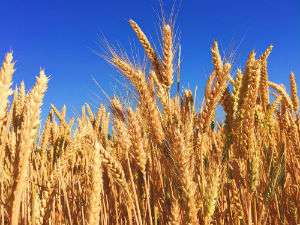Temperature variability and wheat quality

Increased hot and cold spells resulting from climate change could affect bread-making quality or seed quality for growing subsequent wheat crops, depending upon when they occur.
Greater temperature variability is expected in future years as a result of climate change. The effects on plants of so-called unseasonal warm and cold periods in the spring are particularly noticeable to gardeners and farmers.
Brief periods of high, or very cold, temperatures around the time of flowering in wheat can damage pollination and so reduce grain yield substantially.
Scientists at the University of Reading emphasise in new research, published today in Annals of Botany, that subsequent extreme temperature episodes can have more subtle, important effects not only on yield but also on the quality of wheat produced for different markets.
The researchers exposed wheat plants to temperatures warmer or cooler than ambient for different short periods during seed development and maturation and analysed the consequences for a wide range of contrasting parameters of quality. The effects varied depending upon the timing and type of extreme temperature event and the particular aspect of crop quality.
What are the effects of extreme temperatures on crops?
For example, for bread-making high-temperature episodes during early seed filling improved protein content and starch integrity but reduced gluten strength (and also grain yield); starch integrity was also improved by exposure to high temperature later in seed development and maturation.
On the other hand, the quality of seed to grow later crops was reduced by high-temperature episodes during early seed filling but improved if they occur later during maturation; and vice versa for cool-temperature episodes.
Professor Richard Ellis, Professor of Crop Production at the University of Reading, led the research. He said: "Food security is dependent upon crop quality, not just yield. Similarly, farm incomes derive from crop value as well as yield. Climate change impact assessments should consider crop quality as well as yield. Both require particular attention to be paid to the timing of extreme temperature events in relation to crop development.
"Since different grain samples are usually blended for UK bread-making, the various possible changes in the different aspects of bread-making quality with greater temperature variability are unlikely to affect the quality of bread on bakery shelves but will require some accommodation in food processing by millers and bakers because of greater variability than expected in the performance of different grain samples.
"Overall, the research implies that more frequent high-temperature episodes after flowering would improve the proportion of UK-produced wheat meeting most premium market requirements for bread-making or seed; such payments for meeting or exceeding quality thresholds may mitigate the impact of reduced grain yield on farm incomes."
More information: M. Nasehzadeh et al. Wheat seed weight and quality differ temporally in sensitivity to warm or cool conditions during seed development and maturation, Annals of Botany (2017). DOI: 10.1093/aob/mcx074
Journal information: Annals of Botany
Provided by University of Reading
















